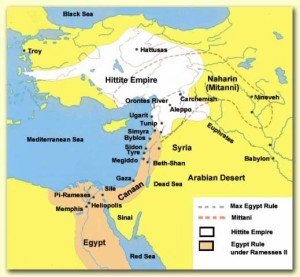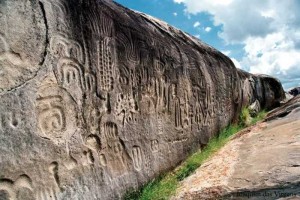John Campbell
Basques *
The Basques of southwestern France and northern Spain have an extremely  ancient and distinctive culture that includes a language, Euskara, with no undisputed link with any other language. The late Larry Trask (1944-2004) provided a sober view(a) of the language while Edo Nyland (1941-2009) perceived extensive links between Basque and other languages, including that of the Ainu people of northern Japan!(l)
ancient and distinctive culture that includes a language, Euskara, with no undisputed link with any other language. The late Larry Trask (1944-2004) provided a sober view(a) of the language while Edo Nyland (1941-2009) perceived extensive links between Basque and other languages, including that of the Ainu people of northern Japan!(l)
Professor John Campbell in a 15-page paper entitled The Hittites in America(e) began his dissertation with a claim that the language of the Iroquois and the Basques were closely related. In Peter de Roo’s History of America Before Columbus[890], he recounts the then (1900) commonly held idea that there was a linguistic link between the Basques and various native American tribes, and puts forward the view that the Basques were originally American[890.1.164].
However fanciful this idea may seem, there appears to be little doubt that the Basques, master whalers of the 16th and 17th centuries(i), had regular contact with the coast of Labrador(j).
An 18th-century abbot, Dominique Lahetjuzan (1766-1818?), announced that his studies indicated that Euskara had been spoken in the Garden of Eden! In the 19th century, S.H. Blanc offered examples[155] from the language that implied great antiquity. One was that the Basque word for knife means literally “stone that cuts,” and that the word for ceiling means “top of the cavern”.
One website(c) is devoted to establishing a link between the Basques, Atlantis and the Algonquins of North America. Bizarrely, at the end of the 19th century, a study of land snails in the Pyrenees led Léopold de Folin to suggest that the ancestors of the Basques came from Atlantis! William Corliss supported the idea of the Basques preceding Columbus and suggested that inscriptions identified as Basque were found in the Susquehanna Valley of Pennsylvania(n).
Alexander Braghine in his own search for Atlantis[156] relates how a Basque missionary when speaking in his own language was understood by the Indians of the Peten district in Guatemala. Dr. James Rendel Harris (1852-1941), the English biblical scholar, claimed that the Mexican province of Tabasco derived its name from an ancient Egyptian word meaning land of the Basques.
A further tale from Braghine records how a person from Georgia in the Caucasus was similarly understood by Basques. This would normally be considered some sort of an urban myth but it should be noted that the linguist Arthur Holmer who is studying(b) the connections between the languages of the Caucasus and Basque believes that the number of similarities is too great to be explained by coincidence alone. A recent (2019) BBC article has highlighted claims of possible linguistic, toponymic, mythological and even DNA links between Armenians and Basques(k). It is interesting that Armenia and Georgia are neighbours.
I have been unable to find any corroboration of the claimed Guatemalan connection with the Basque language.
It is frequently noted that the Basques have a legend that they originally came from Atlantis, which they call Atlaintika. Since names, such as ‘Atlantis’, recorded by Solon were Hellenised versions of the words found in the temple ‘registers’ in Sais, it seems more likely that the Basques would have had a different word to describe any former homeland. It is probable that ‘Atlaintika’ is a modification of a loanword adopted from their neighbours.
In the 19th century, Edward Taylor Fletcher discussed possible links between the Basques and Atlantis in an 1863 paper(m).
Apart from the suggestion of language similarities, some have pointed out facial resemblances between Central American Indians (old Maya or modern Lancadon Indians) and Basques. The Basques believe in a mythical seven-headed serpent (disintegrating comet?), Erensuge while the Aztecs worshipped snakes. The Basques used to count in twenties rather than tens, a practice also found in Central America. The Basque ballgame of jai alai played with a wicker basket tied to the players’ arm is vaguely similar to pok-ta-pok played by the Maya. Fortunately, the Basques did not adopt the Mayan custom of beheading the captain of the losing team. It is reported that both the Basques and the Indians of Mexico and Peru practised artificial head flattening.
The Basques are genetically distinct, having a uniquely high incidence of blood group O, a lower than usual frequency of group A and the lowest record of group B in Europe. They have the highest frequency of Rh-negative blood in the world apart from some Berber tribes.
The Cro-Magnons were tall with larger brain capacities than modern humans. They occupied areas of France and Spain at the end of the last Ice Age. They were similar to the Guanches of the Canary Islands. It is thought that the Basques are related to them. The Cro-Magnons were also artistically talented although limited to primitive tools.
Recent studies have strongly indicated that following a study of the genomes of human skeletons from El Portalón, Atapuerca, the results point to prehistoric Iberian farmers as the closest match to the modern Basques(h).
Overall the evidence for the Basques being remnants of the survivors of Atlantis is weak.
That the Basques are an ancient people is undisputed, but a very early connection with Central America is at best, just remotely possible. That they are the Atlanteans of Plato’s tale is, in my opinion, even more unlikely.
Nevertheless, Dominique Görlitz has written a two-part article for Atlantisforschung in which he offers the suggestion that the Toltecs had been influenced by Basque visitors(o). “In addition to the well-known cultural parallels between the peoples of the Old and New Worlds , many Native American cultures have old myths about foreign culture bringers that relate to the beginnings of their culture and agriculture.”
The latest (2015) genetic studies(f) indicate that the Basques are descended from “early farmers who mixed with local hunters before becoming isolated for millennia.” It was claimed later in 2015 that the origins of the Basques had been discovered in Northern Spain after studying the DNA of eight skeletons found in the El Portolan Cave(g).
A website with a number of English and Spanish papers on the subject of the Basques is also worth a visit(d).
(a) https://www.buber.net/Basque/Euskara/Larry/
(b) Wayback Machine (archive.org) *
(c) See: Archive 2935
(d) https://www.bibliotecapleyades.net/ciencia/ciencia_basques.htm#menu
(e) https://openlibrary.org/books/OL24141925M/Hittites_in_America
(f) https://www.bbc.com/news/science-environment-34175224
(i) https://en.wikipedia.org/wiki/History_of_Basque_whaling
(j) National Geographic (08.2018)
(k) https://www.bbc.com/travel/story/20190603-the-surprising-story-of-the-basque-language
(n) Basken im Susquehanna-Tal vor 2500 Jahren? – Atlantisforschung.de
Hittites
The Hittites ruled an ancient kingdom, which, at its height controlled most of what is now the Asian part of Turkey. They flourished in the middle of the 2nd millennium BC. Despite the size of the Hittite Empire, there are relatively few surviving examples of Hittite art, so it was interesting to read in September 2021 that the oldest known example of Mediterranean mosaic was unearthed at Usakli Hoyuk, near Yozgat, in central Turkey. It is dated to the 15th century BC, 700 years before the earliest Greek example. “It is the ancestor of the classical period of mosaics that are obviously more sophisticated. This is a sort of a first attempt to do it,” says Anacleto D’Agostino, excavation director(f).
The Hittites were among a number of civilisations in the Eastern Mediterranean and Middle East at the end of the second millennium BC to collapse. In the case of the Hittites Sturt Manning has identified a severe multi-year drought that coincided with the Hittite collapse around 1198-1196 BC. Manning et al in a paper published in Nature in 2023 note that “the Hittite collapse forms part of a wider set of changes occurring across the Old World around 1200 BC. Climate alone was not the sole cause of these changes; very different histories are evident within the greater region”(f).
>In 2023, a reasonably intact inscribed tablet was discovered in the ruins of Büklükale which was formerly a major Hittite city. The 3,300-year-old tablet speaks of the catastrophic invasion of four Hittite cities while the Hittites themselves were in the middle of a civil war. “However, the invasion referenced by the newfound tablet doesn’t seem to be related to the Late Bronze Age collapse. Kimiyoshi Matsumura (its discoverer) said the tablet dates to the reign of the Hittite king Tudhaliya II, between about 1380 to 1370 B.C.- roughly 200 years too early” (h).<
Together with the ancient Egyptians, the Hittites are claimed by ‘rogue archaeologist’ David Hatcher Childress to have been the successors of Atlanteans. He  quotes their appearance, dress and construction techniques to support this contention. However, Childress’ views are very much at odds with the opinion of the professional archaeologist, Eberhard Zangger, who has identified some of the petty states to the west of the Hittite Empire as part of the alliance of Sea Peoples(d) and in that same region, Zangger equates Troy with Atlantis. rather than the enemies to the east.
quotes their appearance, dress and construction techniques to support this contention. However, Childress’ views are very much at odds with the opinion of the professional archaeologist, Eberhard Zangger, who has identified some of the petty states to the west of the Hittite Empire as part of the alliance of Sea Peoples(d) and in that same region, Zangger equates Troy with Atlantis. rather than the enemies to the east.
However, Iurii Mosenkis has published a short paper(e) in which he directly associates the Hittites with Atlantis and the Sea Peoples.
Childress describes them as great seafarers and he attributes to them the exploitation of the vast American copper reserves of North Michigan[620 ch.2].
The idea of Hittites in America is in no way new, as John Campbell (1840-1904) published a paper(b) with that very title in 1881, which is now available online.
The renowned, if controversial, epigrapher, Professor Barry Fell identified the writing on the Newberry Stone, found in 1896 in Michigan, as Hittite-Minoan. As there is no such language as Hittite-Minoan and the ancient exploitation of the Michigan copper mines by Old World traders is unproven(a), Childress’ claims are based on speculation and flimsy circumstantial evidence, which for me are far from convincing.
Even more exotic  was the claim by Gabriele Baraldi that the Hittites had developed an empire in Brazil, offering as evidence the petroglyphs on the Ingá Rock(c). Baraldi also located Atlantis in northeast Brazil.
was the claim by Gabriele Baraldi that the Hittites had developed an empire in Brazil, offering as evidence the petroglyphs on the Ingá Rock(c). Baraldi also located Atlantis in northeast Brazil.
(a) See Archive 2547
(b) https://openlibrary.org/books/OL24141925M/Hittites_in_America
(c) https://brazilweirdnews.blogspot.ie/2012/09/the-miystery-of-ingas-stone.html
(d) https://luwianstudies.org./
(e) https://www.academia.edu/38743064/The_Hittite_Empire_in_the_myth_of_the_Atlantis
